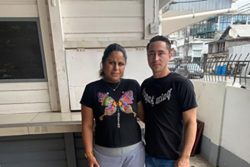Guyana has the second highest rate of adolescent pregnancy in both the Caribbean and South America, with 97 out of every 1,000 girls between the ages of 15 and 19 giving birth, according to the State of the World Population 2013 report.
The report, put out by the United Nations Popula-tion Fund (UNFPA), said that in South America, Ecuador had the highest rate with 100 15 to 19-year-olds out of every 1,000 getting pregnant. The Dominican Republic was cited as having the highest in the Caribbean, with 98 teens out of every 1,000 getting pregnant.
Earlier this year the Government of Guyana (GoG) had told the United Nations Rights of the Child Committee that some 3,000 girls get pregnant each year. The UN report had said that the GoG had considered the issue a matter “of concern.”
The report, subtitled, ‘Motherhood in Child-hood: Facing the Challenges of Adolescent Pregnancy’ stated that the Latin America and Caribbean region has an adolescent birth rate of 73 per 1,000 girls and a maternal mortality ratio of 81 per 100,000 live births. It said motherhood in childhood is an oversized problem that is plaguing the developing world and stripping young girls of their human rights and their physical and psychological health.
Indeed, it added, the rate of teenage pregnancy has escalated into a huge global crisis, with more than seven million teenage girls in poor countries giving birth before the age 18 each year.
The report also revealed that girls under 15 years account for 2 million of the 7.3 million girls that are impregnated each year and if current trends remain, it estimates there will be an upsurge of adolescent births among girls under 15, swelling to 3 million a year in 2030. “Adolescent pregnancy is both a cause and a consequence of rights violation,” the report said, adding that pregnancy at such a young age infringes on a child’s ability to enjoy the basic components of childhood.
“The State of World Population calls for a shift away from interventions targeted at girls towards broad-based approaches that build… [their] human capital, help them make decisions about their lives, including matters of sexual and reproductive health, and offer them real opportunities so that motherhood is not seen as their only destiny,” the report said. “This new approach must target the circumstances, conditions, norms, values, and structural forces that perpetuate adolescent pregnancies on the one hand and that isolate and marginalise pregnant girls on the other. Girls need to have access to both sexual and reproductive health services and to information. They need to be released from the economic and social pressures that too often translate into a pregnancy, as well as poverty, poor health and unrealised human potential that come with it.”
‘Society blames only the girl’
The UNFPA report also called for a shift from the conventional theory that the girl should be blamed. “Too often, society blames only the girl for getting pregnant,” it quoted UNFPA Executive Director Dr Babatunde Osotimehin as saying. “The reality is that adolescent pregnancy is most often not the result of a deliberate choice, but rather the absence of choices, and of circumstances beyond a girl’s control.
“It is a consequence of little or no access to school, employment, quality information and health care.”
The UNFPA report added that impoverished, uneducated girls living in rural areas are more likely to become pregnant than other girls who are educated and wealthy. “Girls from ethnic minorities or marginalised groups and those who have limited or no access to sexual and reproductive health are also at greater risk,” the report said.
According the report, nearly 200 girls die from early pregnancy, which it called, the “ultimate rights violation: death.”
But if their rights are upheld and protected then it will eliminate many of the conditions that add teenage pregnancy and end a vicious cycle of the intrusion of rights, poverty, discrimination and teenage pregnancy, it argues.
The report noted that some governments have not addressed the underlying issues leading to teenage pregnancy, which includes gender equality, poverty, sexual violence, stereotyping of young girls and negative attitudes. It stated that their strategies have habitually revolved around changing the behaviours of the girls.
There is also a string of consequences that attaches itself to a pregnant teen, the report said. It affects the girl’s health, education and rights, and prevents her from realising her potential. The report added that teenage pregnancy has a severe impact on a nation’s economy.
UNFPA is therefore seeking to promote a holistic approach to fight teenage pregnancy by focusing on changing the attitude and actions of society, which includes keeping girls in school, putting an end to child marriage, and increasing adolescent access to sexual and reproductive health care utilities. “We must reflect on and urge changes to the policies and norms of families, communities and government that often leave a girl with no other choice but a path to early pregnancy,” Osotimehin was also quoted as saying. “This is what we are doing at UNFPA and what we will continue to do and recommend until every girl is able to choose the direction of her life, own her future and achieve her greatest potential.”








